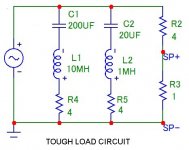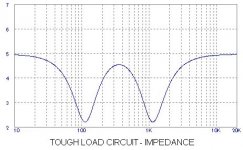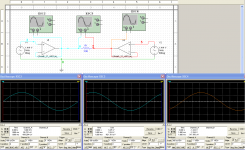Most of the back issues of The Audio Critic are available on-line. I'd strongly suggest reading their power amplifier reviews for a good explanation of the method and some of the data that can be obtained this way.
Thank you for the tip, SY, I am most intersted in the topic so I will investigate.
I have been taken to task by a poster on my website for using 'RMS' power.
I think its a well understood measure and thus a useful benchmark.
Naturally, the peak output power corresponding to I2R delivered power is also important. In most cases though, this power requirement only happens in fairly narrow frequency bands within the speaker response. For most speakers this lies above the LF resonance peak but before 1kHz. Electrostatics are a separate case of course.
I think a decent amp should gracefully handle 3 Ohm or maybe even 2 Ohm impedance dips in the load at certain frequencies - there is not really the need to be able to drive full power continuously at these levels.
For the nx-amp, I used a 500VA transformer and get 180W per channel into 4 Ohms. Rated at 100W into 8 Ohms. I see some commercial amps rated at say 100W into 8 Ohms, and 140W into 4 Ohms - I think that's a bit loose and would pair an amp like that with a benign speaker load.
I think its a well understood measure and thus a useful benchmark.
Naturally, the peak output power corresponding to I2R delivered power is also important. In most cases though, this power requirement only happens in fairly narrow frequency bands within the speaker response. For most speakers this lies above the LF resonance peak but before 1kHz. Electrostatics are a separate case of course.
I think a decent amp should gracefully handle 3 Ohm or maybe even 2 Ohm impedance dips in the load at certain frequencies - there is not really the need to be able to drive full power continuously at these levels.
For the nx-amp, I used a 500VA transformer and get 180W per channel into 4 Ohms. Rated at 100W into 8 Ohms. I see some commercial amps rated at say 100W into 8 Ohms, and 140W into 4 Ohms - I think that's a bit loose and would pair an amp like that with a benign speaker load.
Last edited:
Nice George, thanks.
It appears that the system only tests fundamentals. It is not stated that it can apply a secondary higher frequency added to the first lower high power one, to ***** stability of the secondary signal through all quadrants. Like, um, music into a multiway speaker..
Interesting. the filter removed a word which means "determine" or "evaluate" but began with the letter a.
John
It appears that the system only tests fundamentals. It is not stated that it can apply a secondary higher frequency added to the first lower high power one, to ***** stability of the secondary signal through all quadrants. Like, um, music into a multiway speaker..
Interesting. the filter removed a word which means "determine" or "evaluate" but began with the letter a.
John
Last edited:
If a loudspeaker is rated 8 Ohms it is allowed for the minimum to dip to half that or 4 ohms. As there can also be back EMF generated it can drop to half that again. But for most loudspeakers this will actually be limited by efficiency. So a more reasonable estimate is 60-70% of that or 2.4 ohms for professional loudspeakers and maybe 3.2 ohms for consumer ones.
Now for a 4 Ohm rated loudspeaker....
The lower efficiency loudspeakers will have a higher minimum impedance but also require more power.
The 20 mS power test is pretty much nonsense. But widely used since the FTC no longer worries about it. But for fun look at the specs for a number of kilowatt power amplifiers that run off of a 120 volt (RMS) mains fused at 20 amps. Some are rated 6,400 watts.
Next is what do you actually measure to predict the performance of a power amplifier? Most of the sonic differences are on issues that are rarely measured as they are very difficult to do. Clipping behavior is one well know and easily measured parameter that can make a large difference.
But how do you measure signal induced reductions in S/N ratio?
How do you measure signal dependent power line noise contamination?
J N. Y O U. C A N. G E T. A. L O T. P A S T. T H E. F I L T E R. With little effort.
Now for a 4 Ohm rated loudspeaker....
The lower efficiency loudspeakers will have a higher minimum impedance but also require more power.
The 20 mS power test is pretty much nonsense. But widely used since the FTC no longer worries about it. But for fun look at the specs for a number of kilowatt power amplifiers that run off of a 120 volt (RMS) mains fused at 20 amps. Some are rated 6,400 watts.
Next is what do you actually measure to predict the performance of a power amplifier? Most of the sonic differences are on issues that are rarely measured as they are very difficult to do. Clipping behavior is one well know and easily measured parameter that can make a large difference.
But how do you measure signal induced reductions in S/N ratio?
How do you measure signal dependent power line noise contamination?
J N. Y O U. C A N. G E T. A. L O T. P A S T. T H E. F I L T E R. With little effort.
Last edited:
Now for a bit about what I do...
I just measured a problem area in a stadium.
If I mount a loudspeaker at 0, 35, 145 (X, Y, Z) X = side to side origin, Y depth and Z height.
My seating covers:
96, 0, 0 to 246, 0, 0 and up to 96, 125, 38 by 246, 125, 38
What coverage angle is required for the loudspeaker when used as a point source?
There are a number of programs that will do this, but when I started they were useless and so I did the trig. I still do it to check the programs.
For an extra point what is the distance loss in dB loudspeaker to the closest seat and to the furthest?
My distances are in feet.
Final bonus the maximum SPL from the loudspeaker is is 137 dB at 1 M, so how loud will the sound be at the worst seat. (Trick Question!)
FYI for a Major League Baseball Park, folks will complain it isn't loud enough below 92 dBA or it is too loud above 95 dBA.
I just measured a problem area in a stadium.
If I mount a loudspeaker at 0, 35, 145 (X, Y, Z) X = side to side origin, Y depth and Z height.
My seating covers:
96, 0, 0 to 246, 0, 0 and up to 96, 125, 38 by 246, 125, 38
What coverage angle is required for the loudspeaker when used as a point source?
There are a number of programs that will do this, but when I started they were useless and so I did the trig. I still do it to check the programs.
For an extra point what is the distance loss in dB loudspeaker to the closest seat and to the furthest?
My distances are in feet.
Final bonus the maximum SPL from the loudspeaker is is 137 dB at 1 M, so how loud will the sound be at the worst seat. (Trick Question!)
FYI for a Major League Baseball Park, folks will complain it isn't loud enough below 92 dBA or it is too loud above 95 dBA.
Last edited:
J N. Y O U. C A N. G E T. A. L O T. P A S T. T H E. F I L T E R. With little effort.
T. O. O. M. U. C. H. W. O. R. K..
john
"Bonsai will fret about 0.06% at 35KHz, but I'm pretty sure I wouldn't be able to here that. "
No - no fretting on my side whatsoever.

Exactly, Andrew, you have nothing to fret about, you did it.
I have been taken to task by a poster on my website for using 'RMS' power.
I think its a well understood measure and thus a useful benchmark.
Naturally, the peak output power corresponding to I2R delivered power is also important. In most cases though, this power requirement only happens in fairly narrow frequency bands within the speaker response. For most speakers this lies above the LF resonance peak but before 1kHz. Electrostatics are a separate case of course.
I think a decent amp should gracefully handle 3 Ohm or maybe even 2 Ohm impedance dips in the load at certain frequencies - there is not really the need to be able to drive full power continuously at these levels.
For the nx-amp, I used a 500VA transformer and get 180W per channel into 4 Ohms. Rated at 100W into 8 Ohms. I see some commercial amps rated at say 100W into 8 Ohms, and 140W into 4 Ohms - I think that's a bit loose and would pair an amp like that with a benign speaker load.
Agreed, that should indeed be so, however the question is not only will it, but also for how long. As I previously stated, intervals of 1 mS are absurdly short to the point of being meaningless. IEC stanadrds require 20 mS, and personally I beleive 50 mS should really be enough to accommodate most transients witha large leaind edge momentarily overshooting. Anyway, I adjsut my protection current limiting to activation in around 50 mS and I haven't noticed anything odd happening even when it does activate. Ultimately, even if distortion does rise a bit, that's still way better than any clipping or hard limiting (as usually happens with aggressive limiting).
That's why Audio Critic used Power Cube measurements. It amazes me that no other review publication seems to do so, though at least Stereophile uses a single simulated speaker load to show frequency response variations due to source impedance.
German Audio Magazin uses Power Cube.
If by RMS power, we mean the continuous average power delivered to a load resulting from an applied RMS voltage or current, then it is in its way a misnomer, but generally understood. It's a term that evolved to some extent in reaction to a bunch of specsmanship terms that made amplifiers sound as if they were a lot more powerful. Instantaneous peak power gave way to more bizarre terms, especially in the land of severely underpowered amps like those encountered in the cheapest of cheap speakers.I have been taken to task by a poster on my website for using 'RMS' power.
I think its a well understood measure and thus a useful benchmark.
And of course at that, regardless of the amplifier description, the more telling measure of how loud something plays is sound pressure level. But hardly anyone publishes that, even if they bother, if able, to make acoustical measurements. It is still all about watts for most blurb writers.
This RMS measurement vs Average power, calibrated to RMS values is a quibble. Of course, continuous power (within reason) like 5min vs load is a wonderful test of an amp. Power cube measurements would be almost meaningless with my power amps, and that is why we don't do them.
Interesting about the performance into tough loads. We use the
Tannoy 15" HPD coaxials, which are efficient and benign, as a reference.
We also can run them through a "tough load" as part of the
listening tests, which attenuates the sensitivity by 14 dB and also
loads the amplifier. This allows a good subjective comparison and
gives us a sense of the amplifier over a range of loads.

Tannoy 15" HPD coaxials, which are efficient and benign, as a reference.
We also can run them through a "tough load" as part of the
listening tests, which attenuates the sensitivity by 14 dB and also
loads the amplifier. This allows a good subjective comparison and
gives us a sense of the amplifier over a range of loads.
Attachments
Power cube measurements would be almost meaningless with my power amps, and that is why we don't do them.
They are absolutely relevant. And your amps do well on them.
more than a quibble
Klipsch held forth on the subject in a note in 1972 but it costs money to read it.
Hi Fi Writer - Meaningless RMS powerThis RMS measurement vs Average power, calibrated to RMS values is a quibble. Of course, continuous power (within reason) like 5min vs load is a wonderful test of an amp. Power cube measurements would be almost meaningless with my power amps, and that is why we don't do them.
Klipsch held forth on the subject in a note in 1972 but it costs money to read it.
Interesting about the performance into tough loads. We use the
Tannoy 15" HPD coaxials, which are efficient and benign, as a reference.
We also can run them through a "tough load" as part of the
listening tests, which attenuates the sensitivity by 14 dB and also
loads the amplifier. This allows a good subjective comparison and
gives us a sense of the amplifier over a range of loads.

Very nice Nelson - thanks for sharing.
The new model of PowerCube uses active loading.
http://new.audiograph.se/wp-content/uploads/2013/12/Watercooled_Loadbox_OperationManual.pdf
That’s a very clever implementation. See pages 5 to 10 for details
Simulation and some calculations will reveal the secrets for voltage-current phasor diagrams, then a semi-manual diy version is feasible
George
http://new.audiograph.se/wp-content/uploads/2013/12/Watercooled_Loadbox_OperationManual.pdf
That’s a very clever implementation. See pages 5 to 10 for details
Simulation and some calculations will reveal the secrets for voltage-current phasor diagrams, then a semi-manual diy version is feasible
George
Attachments
Last edited:
- Status
- Not open for further replies.
- Home
- Member Areas
- The Lounge
- John Curl's Blowtorch preamplifier part II


